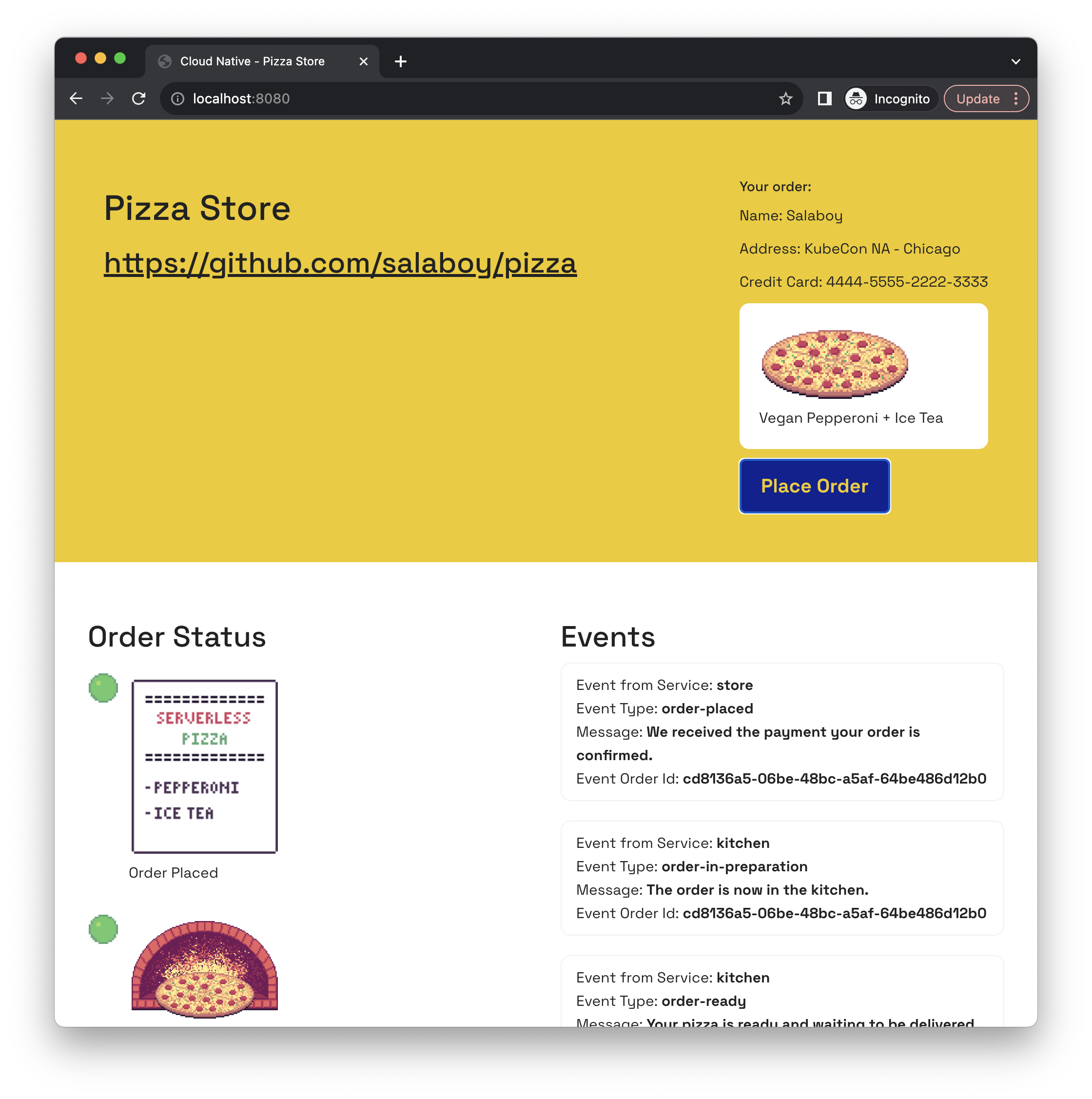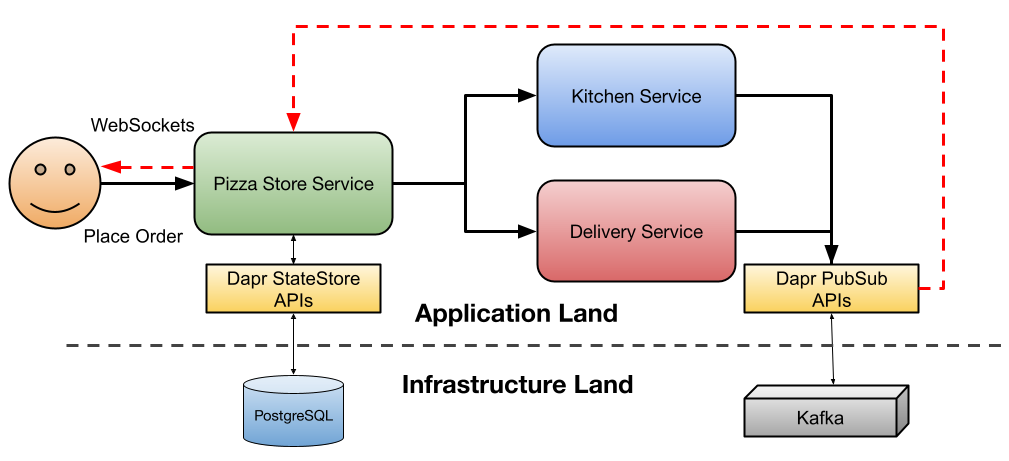This repository contains a simple example for a Pizza Store application using Kubernetes, Dapr, Spring Boot and Testcontainers to enable developers with an awesome developer experience. You can find a Quarkus implementation of this application here (Thanks to @mcruzdev1!)
You can run this application on any Kubernetes cluster by following the step-by-step insturctions described in this document. You can also start each service using just Maven.
The Pizza Store application simulates placing a Pizza Order that is going to be processed by different services. The application is composed by the Pizza Store Service which serve as the front end and backend to place the order. The order is sent to the Kitchen Service for preparation and once the order is ready to be delivered the Delivery Service takes the order to your door.
As any other application, these services will need to store and read data from a persistent store such as a Database and exchange messages if a more event-driven approach is needed.
This application uses PostgreSQL and Kafka, as they are well-known components among developers.
As you can see in the diagram, if we want to connect to PostgreSQL from the Pizza Store Service we need to add to our applications the PostgreSQL driver that must match with the PostgreSQL instance version that we have available. A Kafka client is required in all the services that are interested in publishing or consuming messages/events. Because you have Drivers and Clients that are sensitive to the available versions on the infrastructure components, the lifecycle of the application is now bound to the lifecycle of these components.
Adding Dapr to the picture not only breaks these dependencies, but also remove responsabilities from developers of choosing the right Driver/Client and how these need to be configured for the application to work correctly. Dapr provides developers building block APIs such as the StateStore and PubSub API that developer can use without know the details of which infrastructure is going to be connected under the covers.
When using Dapr, developers can trust that the building block APIs are stable, while the teams in charge of the infrastructure can swap versions and services without impacting the application code or behavior.
If you don't have a Kubernetes Cluster you can install KinD to create a local cluster to run the application.
Once you have KinD installed you can run the following command to create a local Cluster:
kind create cluster
Then we will install Dapr into our fresh new cluster by running the following command:
helm repo add dapr https://dapr.github.io/helm-charts/
helm repo update
helm upgrade --install dapr dapr/dapr \
--version=1.12.3 \
--namespace dapr-system \
--create-namespace \
--wait
We will be using Kafka for sending messages between services:
helm install kafka oci://registry-1.docker.io/bitnamicharts/kafka --version 22.1.5 --set "provisioning.topics[0].name=events-topic" --set "provisioning.topics[0].partitions=1" --set "persistence.size=1Gi"
We will be using PostgreSQL as our persistent store, but before installing the PostgreSQL Chart run:
kubectl apply -f k8s/pizza-init-sql-cm.yaml
Then:
helm install postgresql oci://registry-1.docker.io/bitnamicharts/postgresql --version 12.5.7 --set "image.debug=true" --set "primary.initdb.user=postgres" --set "primary.initdb.password=postgres" --set "primary.initdb.scriptsConfigMap=pizza-init-sql" --set "global.postgresql.auth.postgresPassword=postgres" --set "primary.persistence.size=1Gi"
To install the application you only need to run the following command:
kubectl apply -f k8s/
This install all the application services. To avoid dealing with Ingresses you can access the application by using kubectl port-forward, run to access the application on port 8080:
kubectl port-forward svc/pizza-store 8080:80
Then you can point your browser to http://localhost:8080 and you should see:
The application services are written using Java + Spring Boot. These services use the Dapr Java SDK to interact with the Dapr PubSub and Statestore APIs.
To run the services locally you can use the Testcontainer integration already included in the projects.
For example you can start a local version of the pizza-store service by running the following command inside the pizza-store/ directory (this requires having Java and Maven installed locally):
mvn spring-boot:test-run
This, not only start the pizza-store service, but it also uses the Testcontainers + Dapr Spring Boot integration to configure and wire up a Dapr configuration for local development. In other words, you can now use Dapr outside of Kubernetes, for writing your service tests without the need to know how Dapr is configured.
Once the service is up, you can place orders and simulate other events coming from the Kitchen and Delivery services by sending HTTP requests to the /events endpoint.
Using httpie this look like this:
http :8080/events Content-Type:application/cloudevents+json < pizza-store/event-in-prep.json
In the Application you should see the event recieved that the order moving forward.
- Platform engineering on Kubernetes Book
- Testcontainers for Go Developers
- Cloud native local development with Dapr and Testcontainers
Feel free to create issues or get in touch with us using Issues or via Twitter @Salaboy



